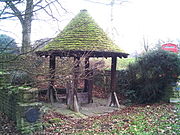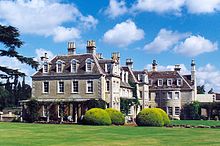Human settlement in England
| Witham on the Hill | |
|---|---|
 St Andrew, Witham on the Hill St Andrew, Witham on the Hill | |
 | |
| Population | 260 (2011 census) |
| OS grid reference | TF053165 |
| • London | 85 mi (137 km) SSE |
| Civil parish |
|
| District | |
| Shire county | |
| Region | |
| Country | England |
| Sovereign state | United Kingdom |
| Post town | BOURNE |
| Postcode district | PE10 |
| Dialling code | 01778 |
| Police | Lincolnshire |
| Fire | Lincolnshire |
| Ambulance | East Midlands |
| UK Parliament | |
| |
Witham on the Hill is a village and civil parish in the South Kesteven district of Lincolnshire, England. The population of the civil parish was 260 at the 2011 census.
History

The hall is a Grade II listed building, dating from ca 1730 but extended several times. The hall was once owned by descendants of Archdeacon Robert Johnson, the founder of Oakham and Uppingham Schools, including Lieutenant-General William Augustus Johnson MP.
The parish church is dedicated to Saint Andrew. The tower and steeple were re-built in a medieval revival style by the Stamford architect George Portwood in 1737–8.
The original village stocks and whipping post are preserved under a modern canopy.
In 2002, West Farm (on the Little Bytham road) had trials for GM rapeseed planted by Aventis.
Geography
The village is between the east and west tributaries of the River Glen, and despite its name, is not on the top of its 'hill', which reaches a peak 1 mile (1.6 km) west towards Careby. It is approximately 0.5 miles (0.8 km) from the A6121 Bourne-Stamford road. To the west is Little Bytham, and to the east are Manthorpe and Toft. The predominant landowner in the area is the Grimsthorpe Estate.
The civil parish covers a large area, extending north into Grimsthorpe Park and Dobbins Wood where it meets the boundary of Edenham, and the boundary with Toft with Lound and Manthorpe is mostly along the A6121. Manthorpe, Bourne used to be part of the civil parish.
Community

The village has a co-educational preparatory school, Witham Hall, which marked its 50th year in 2009. The nearest state primary school is on Creeton Road in Little Bytham. Secondary schools are in Bourne.
The Six Bells public house was built in 1905 by the architect A. N. Prentice and is Grade II listed. It is on the road to the A6121. When built, the parish church did have six bells, but in 1932 they were augmented to eight.
References
- "Witham on the Hill". Parishes in Lincolnshire. Lincolnshire county council. Retrieved 17 August 2013.
- "Civil Parish population 2011". Neighbourhood Statistics. Office for National Statistics. Retrieved 4 June 2016.
- Historic England. "Witham Hall and three archways (Grade II) (1240121)". National Heritage List for England. Retrieved 12 June 2017.
- Needle, Rex. "Village history".
- Historic England. "the church (348189)". Research records (formerly PastScape). Retrieved 12 September 2009.
- "Archived copy" (PDF). Archived from the original (PDF) on 22 May 2017. Retrieved 20 November 2017.
{{cite web}}: CS1 maint: archived copy as title (link) - Historic England. "National monument record for stocks (348192)". Research records (formerly PastScape). Retrieved 12 September 2009.
- "GM weeds finally destroyed". Archived press release. Friends of The Earth. 7 December 2001.
- Lean, Geoffrey (28 October 2007). "GM: The Secret Files". The Independent.
The spectre of GM contamination has cost John Turner dear. A succession of trials near his 250 acre farm in Little Bytham, south Lincolnshire, between 2000 and 2002 forced him to stop growing certain crops – suffering heavy financial losses as a result.
- Historic England. "The Six Bells Public House (1240120)". National Heritage List for England. Retrieved 3 May 2020.
External links
 Media related to Witham on the Hill at Wikimedia Commons
Media related to Witham on the Hill at Wikimedia Commons- St Andrew's Church, Witham on the Hill - Church Website
- Bourne Online's Witham page
- Parliamentary Gazetteer entry 1843
- Witham Hall school web site
- "History of Witham on the Hill, in South Kesteven and Lincolnshire". A Vision of Britain through Time. GB Historical GIS / University of Portsmouth. Retrieved 19 August 2013.
- "all 10 records for the parish". PastScape. Historic England. Retrieved 19 August 2013.